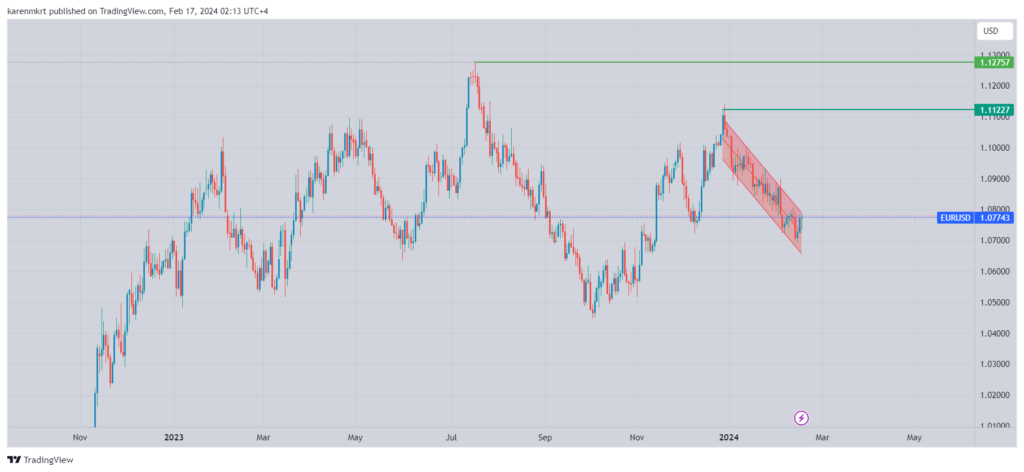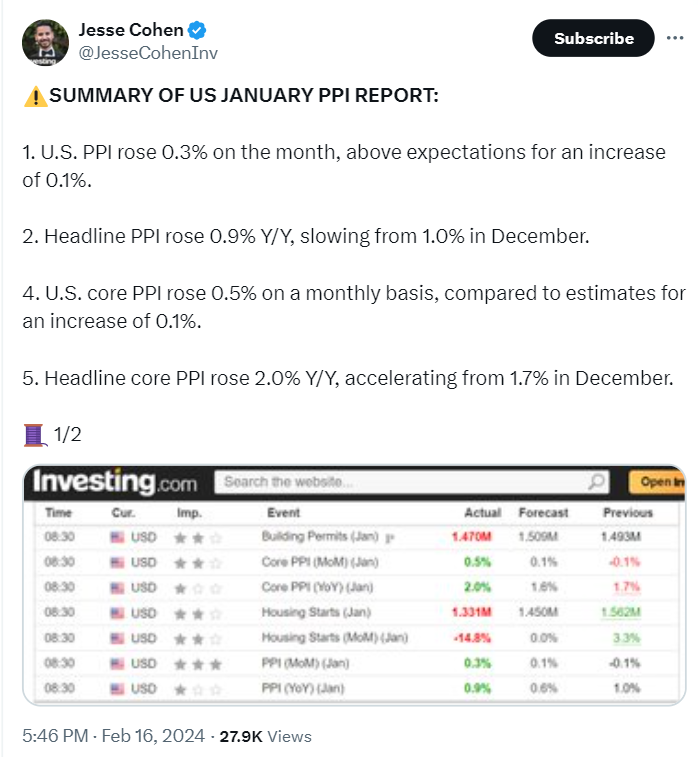
YEREVAN (CoinChapter.com) —The Euro fell from a two-day high as the recent US producer-side inflation hinted the Fed will tighten its monetary policy further. The Greenback, meanwhile, gained momentum as interest rate traders set out to adjust to the Fed’s projected three rate cuts by 2024. Today’s trading session saw EUR/USD fall to a low of 1.0732.
However, the currency soon found support and began showing slight signs of recovery. While writing, the EUR/USD pair trades at 1.0775.

EUR/USD Slips Amid Surge in US PPI
The US Bureau of Labor Statistics reports January’s Producer Price Index rose 0.3% MoM, surpassing expectations. Core PPI also exceeded forecasts, jumping to 0.5% MoM from -0.1% in December.
Moreover, in yearly figures, while the PPI saw a 0.9% increase, slightly lower than December’s, the core PPI recorded a 2% rise, surpassing estimates of 1.6% and December’s 1.8%.
Concurrently, there is a notable decline of 4.7% in single-family housing starts. However, permits for new construction projects see a contrasting trend, rising by 1.6%. This is a nearly two-year high.

According to Rania Gule, Market Analyst at XS.com, the recent EUR/USD reversal can be attributed to the prevailing market optimism surrounding the dollar. The buoyancy comes despite the disappointing US retail sales data.
“The U.S. Dollar Index (DXY) maintains a positive bias, based on the expectation that the U.S. Federal Reserve will avoid interest rate cuts in March and May, with a 52% probability of a 25-basis point rate cut in June. The recent Eurozone Gross Domestic Product (GDP) data for the fourth quarter showed no significant changes,”
Gule wrote in his recent analysis.
European Economy: Modest Growth Amid Challenges
Meanwhile, in the European Union, the economic landscape paints a picture of moderate growth. This is coupled with low inflation amidst both internal and external pressures.
“It is expected that inflation, a key concern for markets, will decrease from 5.4% in 2023 to 2.7% in 2024 before further declining to 2.1% by 2025, indicating the EU’s resilience in facing energy shocks and inflationary pressures, as well as its ability to avoid recession,”
Gule argues.
However, the analyst points out that Germany, the bloc’s largest economy, grapples with formidable challenges. These include recessionary tendencies and surging inflation rates.
The Euro/Dollar exchange rate remains tethered to the monetary policy of the European Central Bank (ECB). Additionally, the EU’s adeptness in navigating foreign policy issues, particularly concerning trade dynamics and geopolitical tensions, will impact the pair’s rate.
Domestic and international issues in the US and the EU will exert significant influence on the EUR/US rate. Gule believes the future trajectory of the currency pair will be contingent on the efficacy of policy measures deployed by the US and EU authorities in addressing prevailing challenges.


